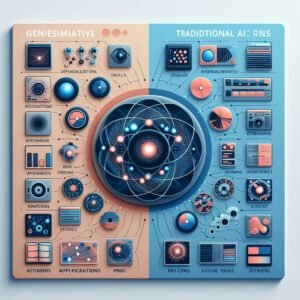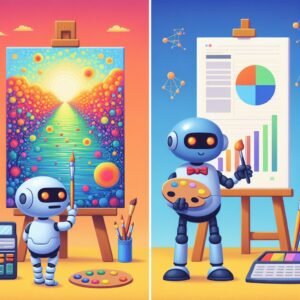Generative AI is reshaping industries, but it comes with its own set of challenges. In today’s technology landscape, understanding the advantages and disadvantages of Generative AI is crucial. In this comprehensive guide, we will explore the remarkable benefits and potential drawbacks of Generative AI. By the end, you’ll have a well-rounded understanding of this transformative technology.

Generative AI Advantages
Section 1: Creativity Enhancement
Generative AI fuels creative expression in art and design. This technology enhances creativity in various domains, from generating artwork to composing music. It fosters innovation by providing new tools for artists and creators. For example, AI-powered art generators like DeepDream produce mesmerizing visuals, showcasing the potential for creative collaboration between humansand machines.
Section 2: Productivity Improvement
Generative AI streamlines workflows, saving valuable time. It automates tasks like content generation and data analysis, allowing professionals to focus on higher-level tasks. Consider chatbots that provide instant customer support or AI-driven content creation tools that assist marketers in producing engaging materials. These applications optimize productivity across industries.
Section 3: Cost Savings
Generative AI drives cost-efficiency across industries. By automating processes and reducing the need for manual labor, businesses can significantly cut operational expenses. For instance, AI-powered chatbots handle customer inquiries 24/7, reducing the need for large customer support teams. This not only saves money but also improves customer service.
Section 4: Efficiency Enhancement
Generative AI accelerates decision-making by processing vast amounts of data quickly and accurately. It streamlines complex processes, such as data analysis and supply chain management. For example, predictive analytics powered by AI can help businesses make data-driven decisions in real-time, improving overall efficiency.
Section 5: Education Benefits
Generative AI revolutionizes education. It enables adaptive learning, personalized education experiences, and teacher training. AI-driven platforms can adapt to individual student needs, providing targeted learning materials. Additionally, AI helps educators analyze student performance data to tailor their teaching methods effectively.
Generative AI Disadvantages

Section 1: Misuse
Generative AI misuse poses ethical dilemmas. It can be used for malicious purposes, such as generating deepfake videos or spreading disinformation. Regulating AI misuse presents significant challenges, as technologies advance faster than policies can be established.
Section 2: Job Displacement
Generative AI transforms job landscapes. While it enhances productivity, it also leads to job displacement in some industries. Roles that involve repetitive tasks are most vulnerable. However, efforts to retrain the workforce for AI-related changes are underway, aiming to mitigate this issue.
Section 3: Bias and Discrimination
Generative AI must overcome bias challenges. AI algorithms can exhibit bias when trained on biased data. This can result in discriminatory outcomes, impacting decision-making processes and perpetuating inequalities. Developing ethical AI that mitigates bias is crucial.
Section 4: Data Quality Dependency
Generative AI relies on high-quality data. The outcomes are directly influenced by the quality of the input data. Ensuring clean and reliable data sources is essential. Data quality assurance becomes a critical part of AI implementation.
Section 5: Ethical Concerns
Ethical considerations in Generative AI are paramount. AI-generated content, especially in media, raises questions about authenticity and trustworthiness. Addressing these concerns is crucial to maintain the credibility of AI-generated content.
Section 6: Security and Privacy Issues
Security and privacy are vital in Generative AI. AI-driven applications may handle sensitive information, making them potential targets for cyberattacks. Robust security measures and data privacy safeguards are necessary to protect user data.
Section 7: Content Quality Concerns
AI-generated content quality remains a focus area. While AI can produce content efficiently, ensuring it meets human standards is a challenge. Continuous refinement and human oversight are essential to improve content quality.
Section 8: Lack of Transparency
Transparency is essential in Generative AI. Understanding how AI algorithms make decisions is often challenging. Efforts to improve AI transparency aim to provide insights into the decision-making process, enhancing trust and accountability.
Comparison with Traditional AI
Comparing Generative AI with traditional AI models reveals key differences and strengths. Generative AI excels in creative tasks, while traditional AI focuses on rule-based automation. Understanding when to use each approach is essential for harnessing their full potential.
Certainly, let’s break down the comparison between Generative AI and traditional AI into a table format using Markdown:
Comparison: Generative AI vs. Traditional AI

| Aspect | Generative AI | Traditional AI |
|---|---|---|
| Core Functionality | Creativity, Content Generation | Rule-Based Automation |
| Approach | Probabilistic, Learning Patterns | Deterministic, Rule-Based |
| Training Data | Large Datasets, Unstructured | Structured Data, Predefined Rules |
| Use Cases | Art Generation, Text Generation | Data Analysis, Task Automation |
| Flexibility | Adapts to New Data Patterns | Limited to Programmed Rules |
| Learning | Semi-Supervised, Self-Learning | Supervised Learning |
| Human Intervention | Minimal, May Require Fine-Tuning | Extensive, Rule Definition |
| Applications | Chatbots, Image Generation | Data Classification, Prediction |
| Complexity | Handles Ambiguity and Creativity | Precise and Predictable |
| Scalability | Scales Well for Creative Tasks | Scalable for Repetitive Tasks |
| Decision Making | Less Predictable, Creative | Consistent, Deterministic |
| Suitability | Creative Content Generation | Repetitive, Rule-Driven Tasks |
Summary:
Generative AI and traditional AI have distinct characteristics and applications:
- Generative AI is best suited for creative tasks, such as art generation and text generation. It adapts to new data patterns, learns from data semi-supervisedly, and requires minimal human intervention once trained. It handles ambiguity well but may require fine-tuning.
- Traditional AI, on the other hand, excels in rule-based automation, making it suitable for tasks like data analysis and task automation. It operates deterministically, relying on predefined rules and structured data. Human intervention is often extensive in defining these rules.
Understanding these differences is crucial for effectively leveraging both approaches to harness their full potential in various applications.Certainly, let’s provide a detailed analysis comparing Generative AI with traditional AI models. We’ll present the information in a markdown table format for clarity:
Comparison between Generative AI and Traditional AI
| Aspect | Generative AI | Traditional AI |
|---|---|---|
| Task Focus | Excels in creative tasks, such as content generation, art, and music creation. | Primarily used for rule-based automation and specific task execution. |
| Learning Approach | Learns from data to generate new content and adapt to various inputs. | Typically relies on predefined rules and algorithms. |
| Use Cases | – Content generation (text, images, videos) – Artistic creativity – Language translation – Chatbots with human-like responses | – Data analysis – Automated systems (e.g., self-driving cars) – Natural Language Processing (NLP) for specific tasks |
| Training Data | Requires large datasets for training, often unstructured data. | Relies on structured data and predefined rules. |
| Adaptability | Adapts well to changing inputs and can generate novel content. | Less adaptable to tasks beyond its predefined rules. |
| Human Interaction | Can simulate human-like responses, making it suitable for chatbots and creative content generation. | Typically interacts with users in a straightforward, rule-based manner. |
| Complexity | Can handle complex and open-ended tasks. | Suited for well-defined, task-specific problems. |
| Computational Resources | Generally requires more computational power and resources for training. | Requires relatively less computational power. |
| Decision-Making | Often lacks explicit decision-making capabilities and generates content probabilistically. | Can make explicit decisions based on predefined rules. |
| Customization | Can be fine-tuned for specific creative tasks with transfer learning. | Customizable for specific tasks by defining rules and algorithms. |
Summary:
Generative AI and Traditional AI have distinct strengths and applications. Generative AI is particularly well-suited for creative tasks, adapting to diverse inputs, and simulating human-like responses, while Traditional AI excels in rule-based automation and specific task execution. Understanding the nature of your task is crucial in choosing the right approach to maximize its potential.
Limitations of Generative AI
Generative AI has limitations and constraints. In certain scenarios, human intervention remains crucial. Recognizing these limitations helps in making informed decisions about AI implementation.
Balancing AI Benefits with Human Creativity
Balancing AI capabilities with human creativity is vital. AI can augment human creativity, offering tools and insights that enhance creative processes. Successful human-AI collaborations, such as in film and design, showcase the synergy between human ingenuity and AI assistance.
Potential for Innovation and Efficiency in Product Design
Generative AI has immense potential in product design. It can lead to innovation by generating novel design concepts and optimizing product development processes. Real-world examples, such as AI-generated fashion designs, highlight the transformative impact of AI in product design.
Use Cases and Applications
Generative AI finds applications across various industries, from healthcare to entertainment. It transforms healthcare with disease diagnosis and drug discovery. In entertainment, AI generates music and assists in film production. These use cases demonstrate AI’s versatility and potential impact.
Related Search Results and Questions (FAQ Section)
Q: What are some ethical concerns in Generative AI?
A: Ethical concerns in Generative AI include issues related to bias, discrimination, and the creation of misleading content. Addressing these concerns is crucial for responsible AI use.
Q: How does Generative AI impact job displacement?
A: Generative AI can lead to job displacement in industries with repetitive tasks, but efforts are underway to retrain the workforce for AI-related changes.
Q: What are the key advantages of Generative AI in education?
A: Generative AI benefits education through adaptive learning, personalized experiences, and improved teacher training, enhancing the learning process for students.
Q: How can Generative AI be used in product design?
A: Generative AI can optimize product design by generating innovative concepts and streamlining development processes, leading to more efficient and creative product design.
Conclusion
Generative AI offers remarkable advantages, from enhancing creativity to improving productivity and efficiency. However, it comes with challenges related to misuse, bias, job displacement, and ethical concerns. Balancing the benefits of Generative AI with responsible use and human creativity is essential. As this technology continues to evolve, understanding its potential and limitations is crucial for informed decision-making.
Explore the full potential of Generative AI at AISourceHub.com and discover how AI is shaping the future of digital marketing and beyond.
Additional Resources:

